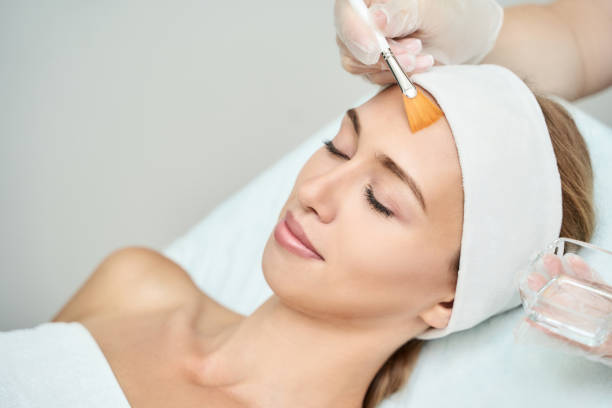Chemical peels are a widely used cosmetic treatment designed to improve skin texture, reduce pigmentation, and treat acne scars. While generally safe when performed by professionals, chemical peels do carry certain risks. In Islamabad, professional Chemical Peel in Islamabad services focus on minimizing complications while delivering effective results. In this blog, we will explore the potential risks associated with chemical peels, factors that increase risk, and how to safely enjoy the benefits of this treatment.
What Are Chemical Peels?
A chemical peel is a procedure in which a chemical solution is applied to the skin to remove the outer damaged layers. This controlled exfoliation promotes:
- Renewal of skin cells
- Collagen and elastin production
- Smoother, more radiant skin
- Reduction of acne scars, fine lines, and pigmentation
Chemical peels vary in strength—superficial, medium, and deep. The depth of the peel largely determines both the effectiveness and the risk of side effects.
Common Risks of Chemical Peels
While chemical peels are generally safe, they can carry certain risks, especially if not performed correctly or on unsuitable skin types.
1. Redness and Irritation
- Mild redness and irritation are common after superficial peels.
- Medium and deep peels may cause more pronounced redness lasting several days.
- Proper aftercare helps minimize discomfort and supports healing.
2. Peeling and Flaking
- Chemical peels cause the skin to peel as dead layers are shed.
- Superficial peels result in light flaking, while medium or deep peels may cause significant peeling.
- Following professional guidance on moisturizers and gentle care reduces irritation.
3. Hyperpigmentation or Hypopigmentation
- Darker skin types are more prone to post-inflammatory hyperpigmentation.
- Superficial and medium peels performed improperly may cause uneven pigmentation.
- Rarely, chemical peels can cause hypopigmentation (loss of skin color) in treated areas.
Professional evaluation and patch testing can help reduce this risk.
4. Scarring
- Though rare, scarring can occur, particularly with medium or deep peels.
- Individuals prone to keloids or abnormal scarring are at higher risk.
- Expert application and proper aftercare are essential to prevent complications.
5. Infection
- Any disruption of the skin barrier carries a small risk of bacterial, fungal, or viral infections.
- Patients with active infections such as cold sores should delay peels until fully healed.
- Clinics often prescribe antiviral or antibacterial measures if necessary to prevent infection.
6. Sensitivity to Sunlight
- Post-peel skin is highly sensitive to UV rays.
- Exposure can lead to pigmentation issues or sunburn.
- Using a broad-spectrum sunscreen and avoiding direct sun exposure is crucial for safe healing.
Factors That Increase Risk
Certain factors make chemical peel complications more likely:
- Skin Type: Darker or highly sensitive skin increases the risk of pigmentation issues.
- Incorrect Peel Selection: Using a medium or deep peel on sensitive or compromised skin can lead to irritation or scarring.
- Medical Conditions: Skin conditions like eczema, psoriasis, or rosacea may react poorly to chemical peels.
- Medications: Retinoids, isotretinoin (Accutane), and certain antibiotics may increase skin sensitivity and the risk of complications.
- Improper Aftercare: Failing to follow post-peel instructions can slow healing and increase risks.
Professional assessment is critical to evaluate these factors and minimize potential problems.
How to Minimize Risks
1. Consult a Qualified Dermatologist
A professional evaluation ensures your skin is suitable for a chemical peel and helps identify the most appropriate type and strength.
2. Conduct a Patch Test
A patch test on a small skin area can predict how your skin will react to the peel, reducing the risk of adverse reactions.
3. Follow Pre-Peel Guidelines
- Avoid retinoids or exfoliating products for a specified period before treatment
- Protect the skin from sun exposure
- Inform your dermatologist about all medications and skin conditions
4. Follow Post-Peel Care Instructions
- Use gentle moisturizers and avoid harsh skincare products
- Apply broad-spectrum sunscreen daily
- Avoid picking or peeling off flaking skin
5. Choose the Right Peel Depth
- Superficial peels: Safe for most skin types, minimal risk
- Medium peels: Moderate risk, suitable for pigmentation and acne scars
- Deep peels: Higher risk, reserved for severe skin concerns and performed under expert supervision
Signs to Watch for After a Peel
While mild redness and peeling are normal, seek medical advice if you experience:
- Severe or prolonged redness
- Signs of infection (pus, swelling, increased pain)
- Unusual scarring or hyperpigmentation
- Persistent burning or discomfort
Early intervention can prevent long-term complications.
Benefits vs. Risks
While chemical peels carry some risks, their benefits are significant:
- Smoother, more radiant skin
- Reduction of fine lines, acne scars, and pigmentation
- Improved skin texture and tone
With professional guidance, the risks are minimized, making chemical peels a safe and effective treatment for most individuals.
Conclusion
Chemical peels offer remarkable benefits for improving skin texture, tone, and overall appearance. However, like any cosmetic procedure, they carry potential risks such as redness, peeling, pigmentation changes, scarring, and infection. Understanding these risks, selecting the right peel, and following professional guidance is key to safe and effective results.
For safe, professional treatment and personalized care, visit Dynamic Aesthetic Clinic. Their specialized Chemical Peel in Islamabad services are tailored to your skin type and concerns, ensuring effective, long-lasting, and safe results.





Comments